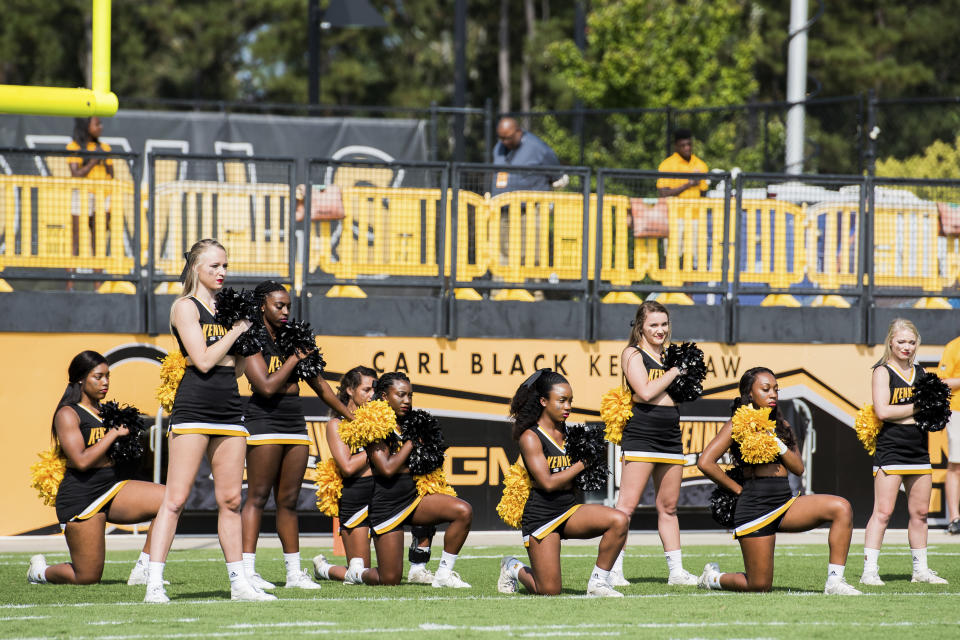Power of kneeling Kennesaw State cheerleaders revealed in president's resignation

Perhaps you missed it, but a notable chapter in America’s civil rights history took place last week in Georgia.
The Kennesaw State University president, Sam Olens, will officially step down from his post in February in the aftermath of five school cheerleaders kneeling during the national anthem before a September football game.
“I have decided that new leadership will be required for KSU to fully realize its potential,” Olens wrote in an email to faculty and students.
There is debate over whether protests during the national anthem have had much of an effect at the NFL level in the months since Colin Kaepernick sat before an August 2016 preseason game. But the protests among the “Kennesaw Five” led to a change at the highest level of their university.
“The KSU cheerleaders will go down in civil rights history,” said Susan Raines, who is a professor of conflict management at the school. “What little power they had made a difference, and that should be a lesson to all of us.”
The cheerleaders’ protest, done to call attention to social inequality and police brutality, led to their banishment to the tunnel for ensuing games. Olens claimed the decision was because of a predetermined pregame protocol plan, but Atlanta-area journalists reported that two high-ranking authority figures, state representative Earl Ehrhart and Cobb County Sheriff Neil Warren, pressured Olens through text messages to put an end to the public displays. When the text exchanges emerged into public view, it looked very much as if the school president had covered up the real reason for the pregame change, and effectively suppressed First Amendment rights.
“I just got off the telephone with [Olens] again, reference the unpatriotic cheerleaders kneeling during the national anthem,” Warren wrote in one reported text. “He assured me that the cheerleaders will not be on field from now on. Thanks for always standing up to these liberal[s] that hate the USA.”
The publicity led to the reversal of the decision and by November, the cheerleaders were back on the field. The University System of Georgia conducted a review and harshly criticized Olens, effectively putting his job on the precipice.
It wasn’t just the kneeling that set all this in motion; the Kennesaw Five remained peaceful from the first protest, refusing to escalate the dialogue toward incivility. There were gatherings, chants, signs and songs, but nothing that would make the wrong kind of headlines. The power brokers, by contrast, looked like shady conspirators.

“Not letting the cheerleaders come out on the field until after national anthem was one of the recommendations that Earl and I gave him!” Warren said in one reported text message.
Carson Byrd, an assistant professor of Pan-African Studies at the University of Louisville, says the Kennesaw episode is an example of “how unconnected higher ed can be.” Instead of teaching students to think for themselves, the message is that the ivory tower will inform them how to think.
“Many of the mission statements of universities are explicitly saying they want students to be great global citizens, and technically peaceful protest is part of that,” Byrd said. “Instead they’re trying to shape what students can or cannot do.”
This is, of course, not new in American history. Back in the 1960s, a rising political star built his reputation on his opposition to campus protests in his home state of California. In 1967, the newly elected governor wrote a letter to the chancellor of San Francisco State College to express his outrage: “How far do we go in tolerating these people & this trash,” the governor asked, “under the excuse of academic freedom & freedom of expression?” That governor was future president Ronald Reagan.
Speech is protected, the message seems to be, until people in power are made uncomfortable by it.
“By trying to be proactive,” Byrd said, “you can make a situation worse.”
That’s what happened at Kennesaw, and the cheerleaders were smart to remain poised as the story unfolded. They got support from other students and, notably, the school mascot, who was roundly criticized by Ehrhart for taking a knee at a campus demonstration.
“I really applaud the cheerleaders,” Raines said. “And when Scrappy took a knee, the feeling was, ‘If they go after Scrappy, it’s on.’ A lot of people still don’t understand the power of the celebrity of sports.”
Indeed, part of the reason a local story became national was because it happened on a football field. That folded it into the wave of media coverage of Kaepernick’s fight and the ongoing protests of NFL players. Opponents of the athletes’ protests railed against the spread of the movement to lower levels of football, but in this instance, it created change that a lot of people on campus wanted.
“It showed me how important using your voice and platform is when it comes to exercising the First Amendment positively,” said Jeffrey Wallace, a KSU senior. “I hope this decision would lead to a fair and proper search for [Olens’] successor.”
There will be more peaceful protests on campus, whether about police brutality or racial inequality or something else. That’s part of the fabric of America. The question will be whether powerful people see those protests as an invitation to begin dialogue, or a reason to quash it.
